Mass measles immunization campaign: experience in the Hong Kong Special Administrative Region of China
Shuk Kwan Chuang,1 Yu Lung Lau,2 Wei Ling Lim,3 Chun Bong Chow,4 Thomas Tsang,5 & Lai Yin Tse5
ABSTRACT: After the 1988 measles outbreak, annual notification rates for measles in Hong Kong SAR between 1989 and 1999 were 0.44.9 per 100 000, with peaks in 1992, 1994 and 1997. The first half-year incidence rates per 100 000 were 2.3 in 1997, 0.5 in 1995 and 1.2 in 1996. Monthly notification rates increased from a baseline of
Keywords Measles/épidemiology/prevention and control; Immunization programs; Measles-mumps-rubella vaccine/administration and dosage/adverse effects; Disease outbreaks/prevention and control; Child, Preschool; Child; Adolescence; Seroepidemiologic studies; Hong Kong (source: MeSH, NLM).
Mots clés Rougeole/épidémiologie/prévention et contrôle; Programmes de vaccination; Vaccin antimorbilleux antiourlien antirubéoleux/administration et posologie/effets indésirables; Epidémie/prévention et contrôle; Enfant âge pré-scolaire; Enfant; Adolescence; Etude séroépidémiologique; Hong Kong (source: MeSH, INSERM).
Palabras clave Sarampión/epidemiología/prevención y control; Programas de inmunización; Vacuna contra el sarampión-parotiditis- rubéola/administración y dosificación/efectos adversos; Brotes de enfermedades/prevención y control; Infante; Niño; Adolescencia; Estudios seroepidemiológicos; Hong Kong (fuente: DeCS, BIREME).
Introduction
Mass "catch-up" measles immunization campaigns are recommended by the World Health Organization (WHO) as one of the main strategies to control or eliminate measles (1). Such campaigns successfully accelerated measles control in the Americas (2, 3) and Eastern Mediterranean and European countries (4). Mass vaccination campaigns can rapidly reduce the proportion of susceptible people, and in some other countries, such as the United Kingdom (1994) (5, 6), Singapore (7), New Zealand (8) and Australia (9, 10), they prevented predicted outbreaks of measles.
The goal of measles control in the Hong Kong Special Administrative Region of China (Hong Kong SAR) is to control the incidence and mortality of measles through routine immunization that gives high coverage levels, and through surveillance. A mass immunization campaign was carried out in 1997 to control an impending epidemic.
This article examines the epidemiological evidence that led to this campaign and assesses its impact on the epidemiology of measles. Some lessons learnt during the campaign are discussed.
Control of measles in Hong Kong SAR
Measles notification
All doctors are required by law to notify cases of measles in Hong Kong SAR to the Department of Health. Institutions such as schools and kindergartens report cases to the Department of Health on a voluntary basis. Every case of measles reported is investigated epidemiologically.
A clinical case of measles is defined as an illness characterized by all of the following clinical features:
temperature ³38.3 oC
generalized rash lasting ³3 days
at least one of cough, coryza or conjunctivitis.
A confirmed case meets the clinical definition above and is either confirmed by a laboratory or linked epidemiologically to a confirmed case. Laboratory confirmation is often carried out by detection of IgM antibodies with commercial kits (such as the Enzygnost Anti-measles Virus/IgM kit, Dade Behring, Germany).
A trained community health nurse takes the patient's clinical history, performs laboratory tests and collects epidemiological data. Blood samples are taken for serology, if possible. Additional cases linked to the reported case are also traced and information about them is collected. Health advice and measles vaccinations are given, when appropriate, to the patients and their contacts, to prevent the disease from spreading. Since 1991, data from both clinical and confirmed cases have been recorded on individual standardized forms, and the information is entered into a computerized database maintained by the Department of Health.
Serological surveillance
The Department of Health conducts serological surveys on measles every year. Serum samples for these surveys come from patients in hospitals and clinics. Serum remaining from samples from patients aged
Routine immunization
Immunization against measles is not legally required in Hong Kong SAR. The measles vaccine was first introduced in 1967, and routine vaccination at 12 months of age is offered by government-run maternal and child health centres and by private doctors. In 1990, a combined measles, mumps and rubella (MMR) vaccine replaced the single antigen measles vaccine.
The coverage rate between 1988 and 1999 had been stable. Between 73% and 83% of locally born children aged 1224 months were known by maternal and child health centres to have received the first dose of the MMR or measles vaccine. This figure was 8587% when the children reached 2 3 years of age. A recent survey among children aged 25 attending kindergartens and childcare centres showed that 99% of children born locally had been given at least one dose of an MMR or measles vaccine compared with only 91.6% of Chinese new immigrant children (11).
In 1996, the continuing occurrence of measles in older children and the experience of other countries prompted the administration of a second dose of MMR vaccine to children of both sexes during "primary 6" (12 years old); this replaced the existing schoolgirl rubella vaccination programme. The routine childhood immunization schedule in Hong Kong SAR then included two doses of MMR vaccine, administered at 12 months (first dose) and 12 years (second dose). In 1996, 99% of all students in primary 6 received two doses of MMR or measles vaccine.
Supplementary "mop-up" immunization
Hong Kong SAR has a compulsory nine-year education system. Since 1989, the immunization status of pupils has been checked during school entry at primary 1 (6 years of age). Between 1989 and 1999, 8591% of students had documented evidence of vaccination with one dose of MMR or measles vaccine at or after 1 year of age. MMR vaccines were offered to the remaining 915% students. The coverage rate of the cohort at primary 1 for one dose of MMR or measles vaccine was 96 99%.
Mass measles immunization campaign
Signs of an impending epidemic
After the major outbreak in 1988, which recorded 3162 notified cases (incidence 56.2 per 100 000 population) and eight deaths (12, 13), sporadic cases and isolated institutional outbreaks of measles continued to occur in unvaccinated children. Despite these, the overall reported incidence remained low, and no major outbreak occurred. Between 1991 and 1996, the overall incidence of measles was maintained at Table 1). No deaths from measles have been reported since 1990.
In 1991 and 1992, measles outbreaks occurred in Vietnamese migrants who stayed in refugee camps; about 80% of these people were not vaccinated. These outbreaks were controlled by intense and frequent immunization campaigns in the refugee camps to increase the vaccine coverage. Among the local population, however, successively higher peaks in measles notification were observed in 1992 (2.7 per 100 000) and 1994 (3.4 per 100 000) (Fig. 1).
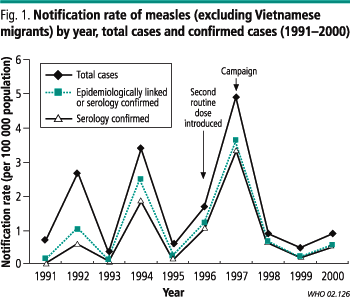
In 1994, the age-specific incidence rate among children aged 1219 years was high (9.6 per 100 000 population), and outbreaks occurred in schools. The proportion of cases with a history of measles vaccination rose from 16% in 1991 to 43% in 1996. This prompted a call in 1996 for the addition of a second dose of the MMR vaccine at the age of 12.
During the first half of 1997, a sharp rise in half-year incidence (2.3 per 100 000) was observed compared with the same periods in 1995 (0.5 per 100 000) and 1996 (1.2 per 100 000). An increase of this magnitude had not been seen since the epidemic of 1988. Monthly notifications rose from a baseline of Fig. 2). Overall, 77% of cases occurred in children under the age of 20 years, mainly in primary school (aged 611 years 27%) and secondary school pupils (aged 1219 years 24%). Almost 80% of the cases were either serologically confirmed or epidemiologically linked to a confirmed case.
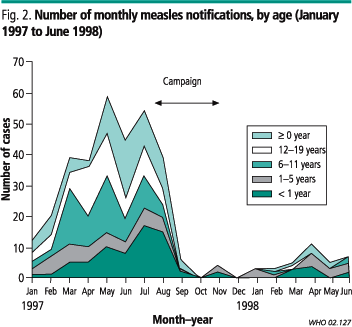
Serological surveys conducted between 1990 and 1996 showed an increase in the proportion of samples negative for measles antibody among persons aged 119 years (Fig. 3). This proportion rose from 8% in 1990 to 14.5% in 1996. The largest rises were seen in those aged 1519 years from 0% to 17%, and 59 years from 2% to 15%. By 1996, the proportion of susceptible children aged 119 years (12%) was higher than in 1988, when the last measles epidemic occurred. People aged 20 years and above showed a high level of immunity against measles.
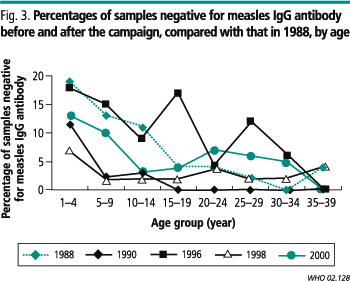
The campaign
The Advisory Committee on Immunization in Hong Kong SAR met in early June 1997 and decided to launch a mass measles immunization campaign to prevent an outbreak. The campaign began on 28 July 1997 and lasted until 15 November 1997 (14). The eligible target group included all children aged 119 years who did not have written proof that they had already been given two doses of MMR or measles vaccine. The MMR vaccine used was M-M-R II (Merck, Sharp and Dohme) a lyophilized product that contains live attenuated measles virus (Edmonston strain), mumps virus (Jeryl Lynn Strain), rubella virus (Wistar RA 27/3 strain) and 25 µg neomycin per 0.5 ml dose.
During the first phase of the campaign (28 July6 September 1997), MMR vaccinations were given to eligible children aged 1219 years at 112 maternal and child health centres and general outpatient clinics run by the Department of Health. During the second phase (8 September15 November 1997), MMR vaccinations were given to children aged 15 years at the health centres and clinics and to primary school children aged 611 years through vaccination teams visiting schools. In addition to efforts by the public sector, private doctors were encouraged to vaccinate eligible children.
The second dose of MMR was brought forward to primary 1 after the campaign in 1998. The children's vaccination status was checked again at primary 6 to ensure that all children had received two doses of MMR vaccine before leaving primary school.
Coverage
During the campaign, a total of 1 100 464 people received MMR vaccines given by the Department of Health (Table 2). The overall coverage provided by the Department of Health was estimated to be 77%. The highest coverage (90%) was achieved in the age group 611 years; this was significantly higher than that for the age groups 15 years (65%) and 1219 years (74%) (P
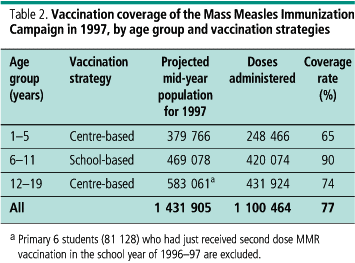
Pharmaceutical companies supplied a total of 56 000 doses of MMR vaccine to the private sector during 1997; this was higher than the approximately 6000 doses provided each year in 1996 and 1998. If we assume that all of the additional 50 000 doses were given to the target population, the total coverage would be increased to 80.3%.
Adverse events after immunization
Immediate reactions to the MMR vaccine were recorded at the place of vaccination. After vaccination, the child or parent was given a pamphlet explaining types of post-vaccination reaction. They were asked to contact maternal and child health centres by phone or in person if any adverse reaction occurred. Doctors in maternal and child health centres assessed individual cases and filled in standardized questionnaires. The records and questionnaires were sent to the statistical unit of the Department of Health for analysis. A reporting system through which public hospitals would notify the Department of Health when they noticed severe adverse effects after MMR vaccination was set up.
Information on the incidence of immediate and delayed adverse events reported after immunization was collected up to 13 December 1997 four weeks after the campaign was completed (Table 3). Immediate reactions related to injections, such as dizziness and fainting, were more likely to occur in girls aged 611 years, but were uncommon for those (15) and Australia (16), but it was still lower than expected (17).

Impact
The first decrease in monthly notification rates was seen in August 1997. Between October and December 1997, only four cases of measles were reported all were less than 5 years old, and two were younger than 1 year.
The incidence of measles fell significantly to less than 1 per 100 000 between 1998 and 2000 (p
Discussion
Since the measles epidemic in 1988, Hong Kong SAR had experienced a relatively long interval with a low incidence of measles (198996). This eight-year period allowed the number of susceptible individuals those who had not been immunized or who were primary vaccine failures to accumulate. The efficacy of measles vaccine has been estimated to be about 9095% on the basis of data from the outbreak in 1988 (12). This suggests a primary vaccine failure rate of 510% among each cohort. Similar to the experiences of other countries, outbreaks occurred in highly immunized schoolchildren (18, 19). In response to this, a second dose of MMR vaccine was introduced in 1996.
By June 1997, there was strong epidemiological evidence pointing to an impending measles epidemic. Sharp rises in the number of cases of measles compared to previous years were seen; the majority of these cases were confirmed, signifying a true rise in incidence. Serological surveillance in 1996 showed that only 85.5% of people aged 119 years had antibodies against measles far below the herd immunity of 95% needed to halt transmission.
The mass campaign appeared to interrupt the outbreak and reduce its magnitude. The number of reported measles cases started to decrease shortly after the start of the campaign, possibly due to the rapid increase in herd immunity among the most susceptible (those aged 1219 years) during the first phase (Fig. 4). Serological data confirmed increased immunity among those aged 119 years.
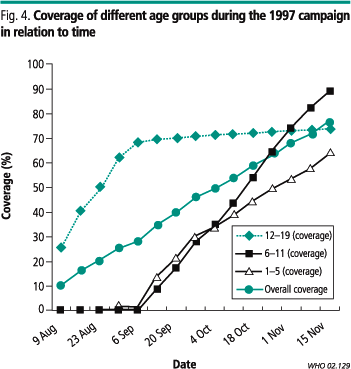
The keys to the success of this campaign were:
the use of accurate and timely epidemiological data to detect warning signs of a measles outbreak
an efficient vaccine delivery mechanism that achieved high coverage in a target population within a relatively short period of time.
Comparisons with similar campaigns
Comparison of the campaign in Hong Kong SAR with similar "catch-up" campaigns in the United Kingdom and New Zealand are revealing. In the British campaign, all children aged 516 years were offered the measlesrubella vaccine. The campaign was implemented exclusively through schools in November 1994, using child health teams. A coverage rate of 92% was achieved (20).
In New Zealand, the target age group was 210 years, and immunization was carried out in schools and by general practitioners and mobile units. A coverage rate of 5685% was reported (8).
While the school-based component of the campaign (targeted at children aged 611 years) in Hong Kong SAR attained coverage comparable with that achieved by the United Kingdom's campaign, the centre-based component produced considerably lower coverage. This shows the advantage of vaccinating a captive population. Among children vaccinated at health centres, older children aged 1219 years had a higher coverage than young children aged 15 years. The campaign was conducted during the summer holidays, when older children had more time to go to vaccination centres. Young children aged 15 years had to be brought by their parents to a vaccination centre, which might have been an impediment for some working parents.
The campaign in Hong Kong SAR covered a wider age band than those in the United Kingdom and New Zealand. The choice of age band was dictated by serological studies and was supported by measles surveillance data.
Comparison between 1997 and 1988
A comparison of the situation in Hong Kong SAR in 1997 with the epidemiology of the measles epidemic in Hong Kong SAR in 1988 is also interesting. Serology data suggest that the impending outbreak in 1997 could have been of comparable magnitude with the outbreak in 1988 in the absence of the vaccination campaign. Most cases (76%) during the 1988 epidemic, however, were in non-immunized children and children younger than 1 year. In 1988, the epidemic was controlled by temporarily lowering the minimum age for MMR vaccination to 6 months and a special "mop-up" campaign (12). Lowering the minimum age for MMR vaccination in 1997 would not have been effective in controlling the outbreak, however.
Adverse events after immunization
No deaths or serious campaign-related adverse events after immunization were reported during the campaign in Hong Kong SAR all reported cases of adverse events after immunization recovered without sequelae. The incidence of adverse events after immunization was higher than that reported in the Philippines and Australia; this is likely to be because different reporting mechanisms were used.
Working towards eradicating measles
The 1997 campaign marks an important step towards the eradication of measles in Hong Kong SAR. Three WHO regions the Americas, the Eastern Mediterranean and Europe have goals for elimination of measles (21, 22, 23). The Western Pacific Region, including Hong Kong SAR, was certified as free from polio in October 2000, and it is logical for us to follow WHO's recommendation that elimination of measles should be our next initiative.
Measles elimination is defined as the interruption of transmission of measles in a sizeable geographical area in which vaccination would nevertheless need to continue because of the continued threat of reintroduction of the virus (24). To do this, we need to keep measles susceptibility at low levels. WHO and UNICEF currently recommend that a "second opportunity" for measles immunization be provided to all children through regular routine or supplemental immunization activities (25).
In Hong Kong SAR, a routine two-dose strategy is in place. The second dose of MMR vaccine was brought forward to 6 years of age after the 1997 campaign, since most of the older children had been immunized during the campaign and nearly 100% coverage can be achieved through school-based vaccination programmes (26). With a supplementary mop-up campaign in schools each year during primary 6 (12 years of age) from the year 1998 onwards, the susceptibility of each cohort after school entry (6 years of age) can be maintained at below 5%.
The issue now is to maintain the age-specific susceptibility of preschool children aged 15 years at low levels. To prevent accumulation of susceptible people when a five-year interval exists between the first and second dose of MMR vaccine, it is necessary to maintain the coverage of preschool children at no less than 90% (27). The coverage of locally born preschool children probably exceeds this figure, although some children may not be receiving the first dose MMR on time. It is important to ensure that children receive a measles-containing vaccine as soon as possible after their first birthday, so that high immunization coverage (>95%) is achieved with the first dose of measles vaccine in each subsequent birth cohort to sustain the impact of the campaign.
The immunization status of preschool children not born locally is not certain. A study conducted by Chow et al. in Chinese new immigrants in 1998 and a recent study suggest that the immunization coverage of Chinese new immigrants is lower than that of locally born children (11, 28). Mechanisms are in place to contact and advise Chinese new immigrant children to receive immunization on schedule once they arrive at Hong Kong SAR; however, their high mobility means that the best strategy may be to vaccinate them at the point of entry to Hong Kong SAR.
Conclusion
Hong Kong SAR should strive to keep susceptibility to measles at low levels through both the two-dose strategy and the mop- up for 12-year-old children. Measles elimination should be our goal after the 1997 mass measles immunization campaign. 
Conflicts of interest: none declared.
Résumé
Campagne de vaccination de masse contre la rougeole : expérience dans la région administrative spéciale de Hong Kong (Chine)
Après la flambée de rougeole de 1988, les taux annuels de notification des cas de rougeole dans la région administrative spéciale de Hong Kong entre 1989 et 1999 ont été de 0,4-4,9 pour 100 000 personnes, avec des pics en 1992, 1994 et 1997. Les taux d'incidence pour le premier semestre étaient de 2,3 en 1997, 0,5 en 1995 et 1,2 en 1996 (pour 100 000 personnes). Les taux mensuels de notification sont passés d'une valeur de base de moins de 10 cas à 59 cas en mai 1997. Les données de la sérosurveillance ont montré que seuls 85,5 % des sujets de 1-19 ans possédaient des anticorps antirougeoleux. Une épidémie, due principalement au défaut de première dose immunisante, semblait imminente à la mi-1997. Une campagne de vaccination de masse axée sur les 1-19 ans a été réalisée de juillet à novembre 1997, avec un taux de couverture global de 77 %. Le taux d'effets indésirables était faible. Après la campagne, l'incidence des cas de rougeole notifiés est tombée à 0,9 pour 100 000 en 1998. Des campagnes supplémentaires et une stratégie comportant l'administration de deux doses permettront de maintenir les taux de sensibilité à la rougeole à un niveau suffisamment bas pour faire de l'élimination de cette maladie notre objectif.
Resumen
Campaña masiva de inmunización antisarampionosa: experiencia en la Región Administrativa Especial de Hong Kong, China
Después del brote de sarampión de 1988, las tasas de notificación anuales para el sarampión en la Región Administrativa Especial de Hong Kong fueron de 0,44,9 por 100 000 entre 1989 y 1999, con máximos situados en 1992, 1994 y 1997. Las tasas de incidencia por 100 000 para la primera mitad del año fueron de 2,3 en 1997, 0,5 en 1995 y 1,2 en 1996. Las tasas de notificación mensuales aumentaron desde un nivel basal inferior a 10 casos hasta 59 en mayo de 1997. La vigilancia serológica mostró que sólo el 85,5% de los niños de 119 años tenían anticuerpos contra el sarampión. A mediados de 1997 parecía inminente una epidemia, debido sobre todo a la ineficacia de la primera dosis como generadora de inmunidad. Entre julio y noviembre de 1997 se llevó a cabo una campaña de inmunización masiva dirigida a los niños de 1 a 19 años. La cobertura general fue del 77%, con una baja tasa de acontecimientos adversos. Después de la campaña, la notificación del sarampión cayó hasta 0,9 por 100 000 en 1998. La combinación de una estrategia de dos dosis y campañas complementarias mantendrán la vulnerabilidad al sarampión a niveles suficientemente bajos para que podamos asumir como objetivo la eliminación de esta enfermedad.
References
1. Clements C J. Global programme for vaccines of the World Health Organization. Role of mass campaigns in global measles control. Lancet 1994;344:174-5.
2. Hersh BS, Tambini G, Nogueira A C, Carrasco P, de Quadros CA. Review of regional measles surveillance data in the Americas, 1996-99. Lancet 2000;355:1943-8.
3. Expanded Programme on Immunization (EPI) measles control/elimination initiatives in the Americas. Weekly Epidemiological Record 1994;69:197- 200.
4. Measles Progress towards global control and regional elimination 1998 1999. Weekly Epidemiological Record 1999;74:429-40.
5. National measles and rubella immunization campaign. Communicable Disease Report 1994;4:147-50.
6. Ramsay M, Gay N, Miller E, Rush M, Morgan-Capner P, Brown D. The epidemiology of measles in England and Wales: rationale for the 1994 national vaccination campaign. Communicable Disease Report 1994;12:R141-6.
7. Singapore Ministry of Health. Measles vaccination. Singapore: Ministry of Health; press release, 14 July 1997. Available from: URL: http://www.gov.sg/ moh/releases/1997/14%20Jul%201997.html (accessed 21 April 2002).
8. Mansoor O, Blakely T, Baker M, Tobias M, Bloomfield A. A measles epidemic controlled by immunization. New Zealand Medical Journal 1998;111:467-71.
9. Forrest J M, Burgess MA, Heath TC, Mcintyre PB. Measles control in Australia. Report of the Measles Control in Australia Workshop, 5 November 1997. Communicable Diseases Intelligence 1998;22:33-6.
10. Anonymous. Immunise Australia program: Measles control campaign. Communicable Diseases Intelligence 1998;22:156.
11. Department of Health Survey on immunization coverage among children aged 2 to 5, 2001. Hong Kong: Department of Health, Hong Kong Special Administrative Region of China. Unpublished document.
12. Lau Y L, Chow C B, Leung T H. Changing Epidemiology of Measles in Hong Kong from 1961-1990 impact of a measles vaccination programme. Journal of Infectious Disease 1992;165:1111-5.
13. Hong Kong Department of Health. Expanded Programme on Immunization: measles outbreak. Weekly Epidemiological Record 1990;65:379-81.
14. Tsang T. Special Measles Vaccination Campaign 1997. Public Health and Epidemiology Bulletin. Hong Kong, Department of Health, 1997.
15. Hartigan-Go K, Roces MC, Habacon CA, Mansoor O, Shin S. Developing an immunization safety surveillance system in the Philippines. Bulletin of the World Health Organization 2000;78:1166.
16. D' Souza RM, Lloyd SC, Isaacs D, Gold M, Burgess M, Tumbull F, et al. Adverse events following immunization associated with the 1998 Australian Measles Control Campaign. Communicable Diseases Intelligence 2000;24:27-33.
17. Immunization safety surveillance: guidelines for managers of immunization programmes on reporting and investigating adverse events following immunization. Manila, World Health Organization Regional Office for the Western Pacific; 1999. WHO Document WPRO/EP1/ 99.01.
18. Cutts FT, Henderson RH, Clements CJ, Chen RT, Patriarca PA. Principles of measles control. Bulletin of the World Health Organization 1991;69:1-7.
19. Gustafson TL, Lievens AW, Brunell PA, Moellenberg RG, Buttery CMG, Sehulster LM. Measles outbreak in a fully immunized secondary-school population. New England Journal of Medicine 1987;316:771-4.
20. Gay N, Ramsay M, Cohen B, Hesketh L, Morgan-Capner P, Brown D, Miller E. The epidemiology of measles in England and Wales since the 1994 vaccination campaign. Communicable Disease Report 1997;7:R17-21.
21. Gay NJ. Eliminating measles no quick fix. Bulletin of the World Health Organization 2000;78:949.
22. Global Control and Regional Elimination 19981999. Morbidity and Mortality Weekly Report 1999;48:1124-30.
23. Epidemiology of measles United States, 1998. Morbidity and Mortality Weekly Report 1999;48:749-53.
24. Measles eradication: Recommendations from a meeting cosponsored by the World Health Organization, the Pan American Health Organization, and CDC. Morbidity and Mortality Weekly Report 1997;46:RR-11.
25. Measles mortality reduction and regional elimination, strategic plan 2001-2005. Geneva: World Health Organization and United Nations Children's Fund; 2001. WHO Document WHO/V&B/01.13.
26. Cutts FT, Markowitz LE. Successes and failures in measles control. Journal of Infectious Disease 1994;170 Suppl:S32-41.
27. De Quadros CA , Olivé JM, Hersh BS, Strassburg MA, Henderson DA, Brandling- Bennett D et al. Measles Elimination in the Americas. Evolving strategies. Journal of the American Medical Association 1996;275:224-9.
28. Chow CB, Tse K. Report of survey on the childhealth status of Chinese new immigrant July-August 1998. Hong Kong Journal of Paediatrics 2000;5:15-24.
1 Kowloon Regional Office, Department of Health, 1/F, Hospital Authority Headquarters Building, 147B, Argyle Street, Kowloon, Hong Kong Special Administrative Region of China (email: shkwchuang@yahoo.com). Correspondence should be addressed to this author.
2 Department of Paediatrics, University of Hong Kong, Pokfulam, Hong Kong Special Administrative Region of China.
3 Government Virus Unit, Department of Health, Hong Kong Special Administrative Region of China.
4 Department of Paediatrics and Adolescent Medicine, Princess Margaret Hospital, Hong Kong Special Administrative Region of China.
5 Department of Health, Hong Kong Special Administrative Region of China.
Ref. No. 01-1324
